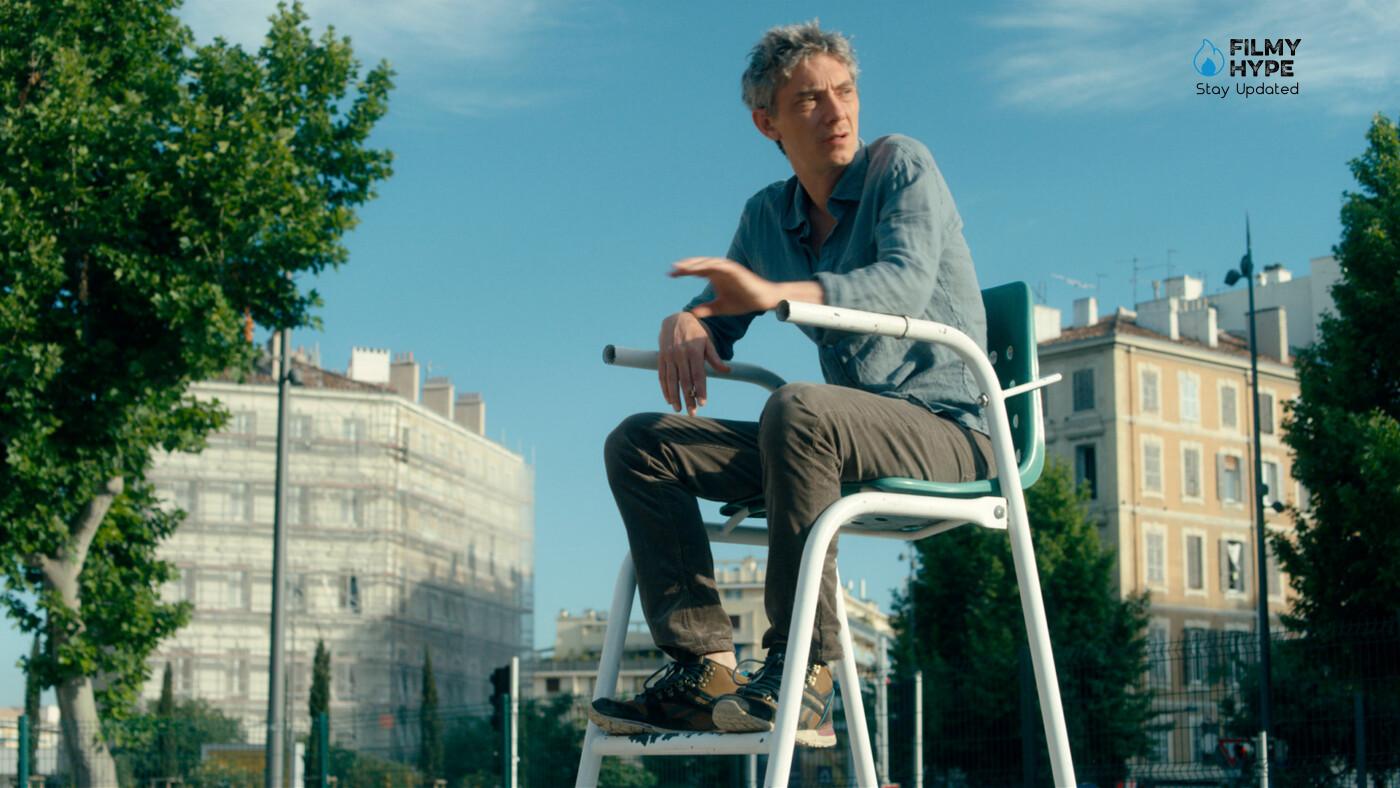Beating Sun Review: Venice 79, A Naturalist Painting With A Rohmerian Taste
Stars: Sarah Adler, Swann Arlaud, Grégoire Oestermann
Director: Philippe Petit
Filmyhype.com Ratings: 3.5/5 (three and a half stars)
Born in 1971, author of shorts and documentaries selected in various international festivals (from Digital Cut in 2010 to Buffer Zone in 2014), Philippe Petit makes his feature film debut with Beating Sun (in original, Tant Que Le Soleil Frappe or “As long as the sun beats”), of which he also signs the screenplay (assisted in the dialogues by Marcia Romano). With the city of Marseille as the main location, the French title was selected for International Critics’ Week, an independent section of the 79th Venice Biennale International Film Festival.

Beating Sun Review: The Story
For his long debut, Petit follows the story of Max (Swann Arlaud), a landscape architect determined to create an open garden in the heart of his city, giving life to an abandoned square that the administration does not seem to care about, to offer an oasis in which the inhabitants can temporarily escape from the frenzy of everyday life. Unfortunately, this dream seems destined to remain a utopia, since the project is too complex and devoid of economic potential, so as not to arouse the interest of eligible investors. Having seen even the last possibility represented by a call for tenders blurred, Max does not lose heart and approaches the architect Paul Moudenc (Grégoire Oestermann), hoping it will help him turn his idea into reality. Promising to think of his proposal, Paul in the meantime proposes to Max to create a private garden for a wealthy client, a job that the landscaper accepts, tired of breaking his back as a gardener in the city park and aware that he too has to provide for his family.
Beating Sun Review and Analysis
Following in the footsteps of French masters such as Éric Rohmer, Petit weaves a narrative plot that rests largely on the characters and their struggles, not to be considered heroic crusades, however, but rather comparisons between systems of ideals in the context of everyday life. Every face in Beating Sun he expresses in his actions and his words his moral compass and his philosophy of life, which inexorably end up colliding with the dominant mentality of contemporary society or the expectations placed by acquaintances. Like the works of the author of the “six moral tales”, the beating heart of the film is above all the dialogues. Aware of this, the director is not afraid to continuously follow his actors closely, remaining glued to them often dedicating long close-ups to them, alternating fixed camera with camera movements by hand, and putting his direction entirely at the service of his interpreters who steer the scene making use of their authentic proofs.
Beating Sun owes a lot to the alchemy among the cast members, which Petit chooses with great care. In addition to carving out a small part, the director entrusts the main roles to experienced actors such as Arlaud, Oestermann and Sarah Adler (in the role of Isabelle, Max’s wife), while surrounding them with non-professionals who often impersonate their own filmic alter egos (the park’s chief gardener holds that position in life, just as the soccer player Djibril Cissé plays himself as the patron of the private garden). A thinning of the boundary between reality and cinematographic fiction reveals an almost naturalistic thrust, through which the title becomes the mirror of a story in which the director appears many times more observer than the author.
However, it would be unfair to say that Petit limits himself to positioning the camera and letting the actors do the bulk of the work. There are many expedients with which the director carries on the fil rouge of Beating Sun, consisting of a continuous game of oppositions. In terms of the script, Max’s idealism collides with the pragmatism of the city administration and architect Paul, but also with his personal responsibilities as a father and husband. This tension is felt above all in the couple dynamics between the man and his wife Isabelle. The latter represents an excellent counterpoint to the dreamy spirit of her husband, whom she would never ask to give up her ambitions, but who is forced to bring her feet back to earth when she believes that his actions can hurt the family and even before himself.
Together with the writing, Adler’s interpretation contributes to giving depth to a character whose role does not end in the function of opposing force to the protagonist. Fought about whether or not to keep the baby he carries. Parallel to the visions of the world expressed by the characters, Petit ensures that discrepancies are also frequent in the images. Wherever Max goes, vegetation accompanies him, often enveloping him. The fact that this happens also and above all when he goes to the spaces inhabited by high society, not only reminds us of what for the protagonist is a real reason for living but emphasizes the social aspect for which while some privileged people can enjoy a luxuriant nature, the same cannot be said for the forgotten inhabitants who live around the neglected square, the only real place where the landscape architect would like to see the greenery grow.
An element, the vegetable one, also recurring in its contrast with the urban landscape, which Petit highlights by photographing several times abandoned land, devastated by huge holes, and the buildings worn by time and smog that surround it. A question and answer, the one between the green of the plants and the gray of brick and asphalt, is emphasized by the soundtrack of the film. The alienating music with an experimental taste, by the Englishman Andy Cartwright, contributes to making Max’s immersion in his goal and, overlapping the mix of natural and urban sounds (or noises), reflect on the possible coexistence between the two worlds, rather than the domination of one over the other.
Beating Sun Review: The Last Words
However, the film’s set-up must not be misleading. Petit has no intention of signing a title that is “intellectual” at any cost, exhausting the audience with his calm step and his focus on dramas as human as they are simple, close to those that we see happening around us every day. The final editing of an hour and twenty, below what is now the average for a feature film (between 95 and 100 minutes), is a clear attestation that the director is not interested in boring the public beyond measure. Without rejecting the complaint with a naturalist character, from which emerges a society impervious to compromise-reluctant dreamers, who seem to have no other weapon than transgression, Beating Sun if anything, is close to the project of its protagonist.







